Known Space is the fictional setting of about a dozen science fiction novels and several collections of short stories by American writer Larry Niven. It has also become a shared universe in the spin-off Man-Kzin Wars anthologies. The Internet Speculative Fiction Database (ISFDB) catalogs all works set in the fictional universe that includes Known Space under the series name Tales of Known Space, which was the title of a 1975 collection of Niven's short stories. The first-published work in the series, which was Niven's first published piece, was "The Coldest Place", in the December 1964 issue of If magazine, edited by Frederik Pohl. This was the first-published work in the 1975 collection.
British author Peter F. Hamilton's The Night's Dawn Trilogy consists of three science fiction novels: The Reality Dysfunction (1996), The Neutronium Alchemist (1997), and The Naked God (1999). A collection of short stories, A Second Chance at Eden, shares the same universe, and The Confederation Handbook documents that universe in non-fiction style.

Space exploration is the use of astronomy and space technology to explore outer space. While the exploration of space is currently carried out mainly by astronomers with telescopes, its physical exploration is conducted both by uncrewed robotic space probes and human spaceflight. Space exploration, like its classical form astronomy, is one of the main sources for space science.

Robert Lull Forward was an American physicist and science fiction writer. His literary work was noted for its scientific credibility and use of ideas developed from his career as an aerospace engineer. He also made important contributions to gravitational wave detection research.
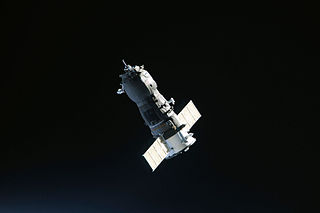
Uncrewed spacecraft or robotic spacecraft are spacecraft without people on board. Uncrewed spacecraft may have varying levels of autonomy from human input, such as remote control, or remote guidance. They may also be autonomous, in which they have a pre-programmed list of operations that will be executed unless otherwise instructed. A robotic spacecraft for scientific measurements is often called a space probe or space observatory.

Fiasco is a science fiction novel by Polish author Stanisław Lem, first published in a German translation in 1986. The book, published in Poland the following year and translated into English by Michael Kandel in the same year, is a further elaboration of Lem's skepticism: in Lem's opinion, the difficulty in communication with extraterrestrial intelligence is more likely cultural disparity rather than spatial distance. It was nominated for the Arthur C. Clarke Award.

Eden is a 1958 social science fiction novel by Polish writer Stanisław Lem. It was first published in 1958 in issues 211-271 of the newspaper Trybuna Robotnicza. The first book edition was in 1959. It was first published in English in 1989 (ISBN 0-15-127580-7).
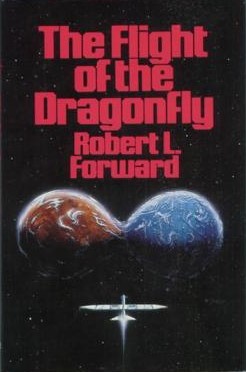
Rocheworld is a science fiction novel by Robert Forward which depicts a realistic interstellar mission using a laser driven light sail propulsion system to send the spaceship and a crew of 20 on a one-way journey of 5.9 light-years to explore a double planet that orbits Barnard's Star, which they call Rocheworld, and where they make many startling discoveries.
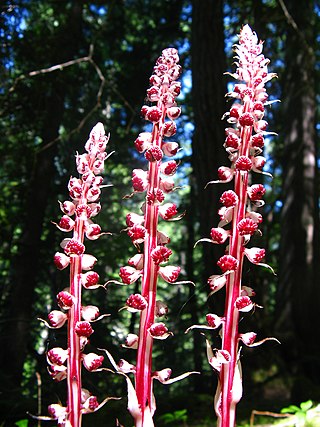
Allotropa virgata is in the family Ericaceae and is the only species of the genus Allotropa. It is a perennial plant that gets its common names from the distinct white and red or maroon stripes along its erect peduncle. A. virgata are nongreen as they lack chlorophyll, instead obtaining nutrition from neighboring green plants through a fungal intermediate.

The following outline is provided as an overview of and topical guide to space exploration.

Return to Rocheworld is a 1993 science fiction novel by Robert L. Forward and Julie Forward Fuller. It is the sequel to Forward's Rocheworld, a novel about the first crewed interstellar mission to a unique double planet orbiting Barnard's Star. It features a return journey to that planet by the crew of the lightsail powered Starship Prometheus.
The Legion of Space is a space opera science fiction series by American writer Jack Williamson. The story takes place in an era when humans have colonized the Solar System but dare not go farther, as the first extra-solar expedition to Barnard's Star failed and the survivors came back as babbling, grotesque, diseased madmen. They spoke of a gigantic planet, populated by ferocious animals and the single city left of the evil "Medusae". The Medusae bear a vague resemblance to jellyfish, but are actually elephant-sized, four-eyed, flying beings with hundreds of tentacles. The Medusae cannot speak, and communicate with one another via a microwave code.
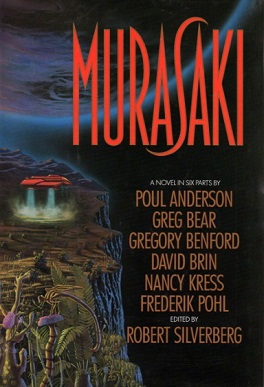
Murasaki is a 1992 "shared universe" hard science fiction novel in six parts to which Poul Anderson, Greg Bear, Gregory Benford, David Brin, Nancy Kress and Frederik Pohl each contributed one chapter; it was edited by Robert Silverberg. It is the first anthology of this type to be entirely conceived and written by winners of the Nebula Award.
In the 2009 science-fiction film Avatar, director James Cameron conceived a fictional universe in which humans seek to mine unobtanium on the fictional habitable moon Pandora. The Earth-like moon is inhabited by a sapient indigenous humanoid species called the Na'vi, as well as varied fauna and flora. Resources Development Administration scientists, administrators, recruits, support, and security personnel travel to Pandora in the 22nd century to discover this beautiful, lush world, which is inhabited by many lifeforms including the human-like Na'vi. The clan with which the humans have contact in the film lives "in a giant tree that sits on a vast store of a mineral called unobtainium, which humans want as an energy supply."
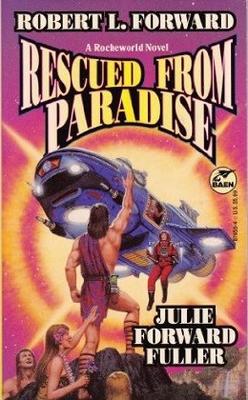
Rescued from Paradise is a science fiction novel by Robert L. Forward, collaborating with his daughter Julie Forward Fuller. It is part of the Rocheworld series, about an expedition to explore planets found in orbit around Barnard's Star. This is the fifth and final book in the continuity. Some material from previous novels was rewritten and included as part of this story. In this novel, after settling down on the habitable moon Zuni, the crew struggle to survive various disasters and to communicate with a mysterious Civilization under the ocean.

Ocean Under the Ice is a science fiction novel by Robert L. Forward, collaborating with his wife, Martha Dodson Forward. It is part of the Rocheworld series, about an expedition to explore planets found in orbit around Barnard's Star. It was written after Marooned on Eden, but is before it in the continuity. This is the third book in the continuity. It follows the crew of humans and Flouwen as they explore Zulu, a moon of the gas planet Gargantua, and encounter 2 sentient species, the icerugs and the coelasharks.
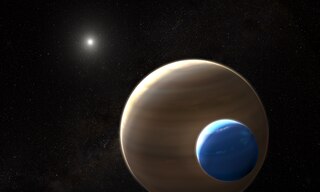
A subsatellite, also known as a submoon or a moonmoon, is a "moon of a moon" or a hypothetical natural satellite that orbits the moon of a planet.
Phobos Surveyor is a mission concept under preliminary study by Marco Pavone of Stanford University, the NASA Jet Propulsion Laboratory (JPL), and the Massachusetts Institute of Technology as a part of NASA's Innovative Advanced Concepts program.
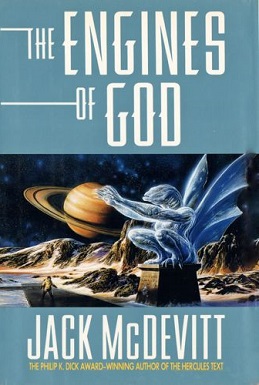
The Engines of God is a science fiction novel by American author Jack McDevitt.

The Big Jump is a science fiction novel by American writer Leigh Brackett, centered on the first crewed expedition to Barnard's Star.















